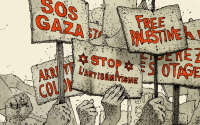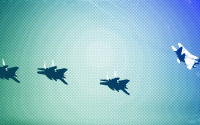The road from the village of Ozbin Khol is safe no longer. The eight aid workers packed into a Toyota LandCruiser were keen to get to their destination, Sarobi, before nightfall. But a punctured tyre stopped them. Two young men, carrying Kalashnikovs, their faces covered by keffayahs, came out of the darkness, lined up the passengers and opened fire, killing five.
The killings, in Paktika province, south-east of Kabul, were at the end of February. The next month, gunmen burst into a guesthouse near the southern city of Kandahar, killing three more aid workers. Two weeks ago, two Europeans, one with a Swiss passport, were stoned and stabbed to death at Bagh Chilsthan, just 15 minutes' drive from the centre of Kabul.
Reports of the murders appeared in the international media, briefly, because the victims were either from the West, or had links with international relief agencies. There have been other deaths - 15 children killed by United States warplanes in raids while attempting to eliminate a warlord in December. Another dozen Afghans were killed in the next few weeks, either enemy combatants, said the Americans, or the result of collateral damage among civilians.
In Herat, internecine fighting between forces of the warlord, Ismail Khan, and the governor sent by Hamid Karzai's government in Kabul led to the deaths of 100 people, including Mr Khan's son.
These are snapshots of a continuing conflict in Afghanistan, a war of attrition taking place largely in the shadows with the focus of the world's media firmly fixed on Iraq.
The Afghan war was, of course, the first chapter of the War on Terror launched after 11 September. After a relatively quick and casualty-free campaign - for the American military, if not Afghan civilians - George Bush declared victory. Tony Blair pledged: "This time we will not walk away", as had happened following the war the mujahedin fought against the Russians with Western money and arms.
But that, say many Afghans, is exactly what the United States and Britain have done. And just as the official end to hostilities in Iraq has been followed by unremitting violence, so the war has returned with a vengeance in Afghanistan. With international interest concentrating on Iraq, aid money has dried up for the Afghans. The military bill for the Pentagon, so far, is $50bn (£27bn). The money for humanitarian work, on the other hand, has been $4.5bn. Out of that, much of the $2.2bn earmarked for this year has been diverted to military projects and emergency relief from long-term development.
Even where aid money is available, the security situation is preventing distribution. The five men killed in Paktika worked for the National Solidarity Programme (SDF), which is now pulling out of 72 areas in the country.
Ihsanullah Dileri, the organisation's head of co-ordination said in his Kabul office: "This is a very bad, very desperate situation. We had $60,000 to spend on each of those 72 areas, now this cannot be done.
"All these areas are badly deprived, with poor people lacking basic facilities. But I am afraid the security simply is not there for us to continue with our work. It is too dangerous."
Barbara Stapleton, of the Agency Co-ordinating Body for Afghan Relief (ACBAR) an umbrella body representing 90 national and international aid agencies, added: "We are very concerned about security and the deterioration of the situation. Impunity rules in the country. It's not just the NGO [non-governmental organisations] community, but the Afghan people at large who are exposed to these levels of insecurity."
There is also evidence that the American military is using aid as a means of acquiring intelligence. Delivering blankets and food to refugees at Dwamanda in the south, Lieutenant Reid Finn had no hesitation in telling journalists: "It's simple. The more they help us find the bad guys, the more good stuff they get." Teena Roberts, the head of Christian Aid's mission in the country, said: "The result of this is aid workers have become targets. I have not come across the use of aid in this way before."
After the fall of the Taliban, the streets of Kabul used to be busy until the 10pm curfew. Now they are deserted by eight in the evening, with the headlights of a few solitary cars hurtling through the darkness. Foreigners travel in convoys, with armed guards. Amanullah Haidar runs a stall 100 yards from the Mustafa Hotel in the city centre, one of the few places deemed to be safe for the expatriate community to meet in the evening, where the two brothers who run it carry pistols in shoulder holsters, and guards with semi-automatic rifles man the main door.
"We are disappointed by lack of progress, lack of money, lack of jobs," said Mr Haidar, a Tajik former Northern Alliance soldier. "I remember all these people who came here from Europe and America and told us how they are going to help us. But where are the factories and the offices we thought we would get? What about the elections we were promised?"
President Hamid Karzai was forced to put back to the autumn elections because of the instability. Only 1.6 million out of 10.5 million eligible to vote have registered. In the Pashtun belt, where Taliban influence is still strong, the number of women registered is below 20 per cent.
The emancipation of women, subjugated by the fundamentalist Taliban, was one of the stated objectives of the West. Even before the war ended America's First Lady, Laura Bush, declared: "Because of our recent military gains in much of Afghanistan, women are no longer imprisoned in their homes. The fight against terrorism is also a fight for the rights and dignity of women."
According to an Amnesty International report, however: "Two years after the ending of the Taliban regime, the international community and the Afghan transitional administration, led by President Karzai, have proved unable to protect women. The risk of rape and sexual violence by members of armed factions and former combatants is still high. Forced marriages, particularly of girl children, and violence against women in the family are widespread in many areas."
After the war, dozens of girls' schools reopened throughout the country. But an Islamist resurgence has seen many of them closed down through intimidation. Families who still dare to send their female children for education can pay a terrible price. Earlier this month, three young girls, aged eight to 10, were poisoned in eastern Afghanistan, apparently as punishment for attending lessons.
The government points out, however, that four million pupils are enrolled in schools this year - including one third of the country's female children.
Twenty-five years of war have destroyed what there was of Afghan infrastructure. In a number of regions, such as the Shomali Plain, the Taliban and their Pakistani allies destroyed centuries-old irrigation systems in a scorched-earth policy against the Northern Alliance.
Following the last war, attempts were made to restore water and power. But systematic strikes by the Taliban on power lines and irrigation projects, and murders of foreign engineers, has ground much of it to a halt. At present, just 9 per cent of the population have access to electricity. Safe drinking water is estimated to be restricted to 6 per cent. The World Bank has authorised a $40m loan for water projects, but while work can begin with the funds in the north and west, it is deemed to be too dangerous in the Pashtun belt of the south and east.
The UN has stressed irrigation is essential for agriculture in a country where the overwhelming majority of the population live in rural areas. However there is no shortage of one particular crop - opium. Poppy cultivation reached a new high last year. According to the White House Office of National Drug Control Policy, the area of cultivation has grown from 1,685 hectares in 2001 to 61,000 hectares in 2003. The country has the dubious distinction of accounting for 75 per cent of the world's output.
FACTS AND FIGURES THAT TELL THE STORY
HEALTH
Pregnancy: One woman dies every 20 minutes in pregnancy/childbirth2002: Pregnancy and childbirth the leading cause of death in women500 trained midwives for female population of 11 million
Life expectancy:
2001: 462004: 43
Under-five mortality rank:
2001: 42004: 4
Measles:
2000: 1,400 cases of measles per month2003: 40 cases per month
Polio:
1999: 27 reported cases2003: 7 reported cases2004: 3 reported cases
CHILD SOLDIERS
8,000 child soldiers in official armyFeb 2004: Government starts to demobilise 2,000 child soldiers400 children killed each month from landmines
EDUCATION
Four million children in education1.2 million girls in education; aim to get a million more girls into education
Net primary school enrolment ratio:
1995-99: M:F 53:52004: M:F 42:15
Total adult literacy:
1995-99: 322004: 36
OPIUM PRODUCTION
2001: 185 tons of opium (reduction of 96 per cent from 1999)2003: Second-largest opium harvest (after 1999) with yield of 3,600 tonsPoppy cultivated in 28 of 32 provinces, involving 1.7 million Afghans. Drug trade income is $2.3bn, more than 50 per cent of Afghanistan's legal GDP69 per cent of farmers surveyed intend to increase cultivation in 2004Nearly 30 per cent of farmers plan to more than double production43 per cent of non-poppy farmers intend to start cultivating in 2004
Sources: UNICEF SOWC (State of the World's Children) annual report); CARE International; Afghanistan Annual Opium Poppy Survey 2001); Afghanistan Farmers' Intentions survey 2003-04); Amnesty International






